Encrypting Network Communication
To protect communicated information, it is necessary to encrypt communication between computers and external equipment.
Data sent from and received by the machine can be intercepted, cracked, or tampered with during transmission. For example, the following data can be transmitted between the machine and external devices or the computer:
Documents printed in the company using the printer driver
Documents scanned and sent by e-mail to use in a meeting
Login user name and login password
See the table below for the methods of encrypting data.
Data to encrypt | Encryption method | Process/Reference within the section |
|---|---|---|
Web Image Monitor IPP print Windows authentication LDAP authentication E-mail transmission | SSL/TLS | Install a device certificate.
|
Machine management data | SNMPv3 | Specify an encryption password.
|
Authentication information of print jobs | Driver encryption key IPP authentication | Specifying a Driver Encryption Key Specify IPP authentication.
|
Kerberos authentication data | Varies depending on the KDC server | Select an encryption method.
|
Installing a Self-signed Certificate/Certificate Issued by a Certificate Authority
To encrypt communication with the machine, install a device certificate.
Two types of device certificates can be used: a self-signed certificate created by the machine and a certificate issued by a certificate authority. When you need higher reliability, use a certificate issued by a certificate authority.

Installing a self-signed certificate/certificate issued by a certificate authority from Web Image Monitor
![]() Log in to the machine as the administrator from Web Image Monitor.
Log in to the machine as the administrator from Web Image Monitor.
![]() Click [Configuration] from the [Device Management] menu.
Click [Configuration] from the [Device Management] menu.
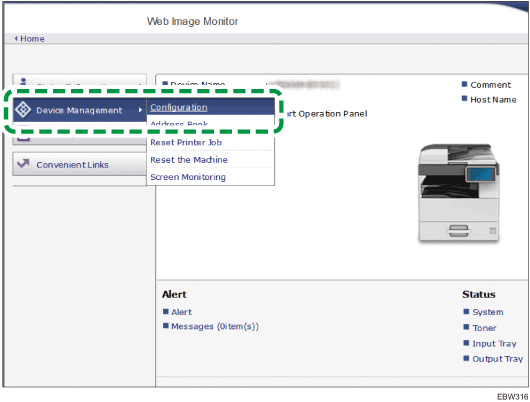
![]() Click [Device Certificate] on "Security".
Click [Device Certificate] on "Security".
![]() On the "Device Certificate" screen, install a self-signed certificate or certificate issued by a certificate authority by following the instructions below:
On the "Device Certificate" screen, install a self-signed certificate or certificate issued by a certificate authority by following the instructions below:
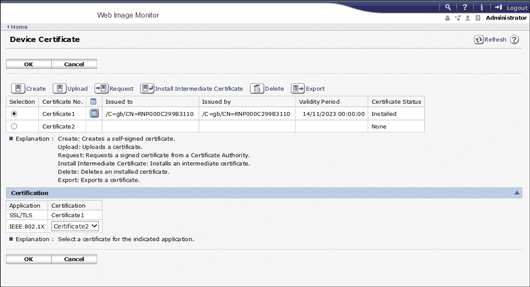
To install a self-signed certificate
Create and install a self-signed certificate.
Select the number from the list to create a self-signed certificate.
Click [Create] to specify the necessary settings.
Common Name: Enter the name of the device certificate to create. You must enter a name.
Enter "Organization", "Organizational Unit", and other items as necessary.
Click [OK].
"Installed" is displayed in "Certificate Status".
To install a certificate issued by a certificate authority
Request a device certificate from a certificate authority and install it. Follow the same steps to install an intermediate certificate.
Select the number from the list to create a device certificate.
Click [Request] to specify the necessary settings.
Click [OK].
"Requesting" is displayed in "Certificate Status".
Apply to the certificate authority for the device certificate.
You cannot apply to the certificate authority from Web Image Monitor. The application procedure varies depending on the certificate authority. For details, contact the certificate authority.
For the application, click the Details icon
 and use the information that appears in "Certificate Details".
and use the information that appears in "Certificate Details".The issuing location may not be displayed if you request multiple certificates at the same time. When you install a certificate, be sure to check the certificate destination and installation procedure.
After the device certificate has been issued by the certificate authority, select the number of the issued certificate from the list on the "Device Certificate" screen, and then click [Install].
Enter the contents of the device certificate in the entry fields.
To install the intermediate certificate at the same time, enter also the contents of the intermediate certificate.
If an intermediate certificate issued by a certificate authority is not installed, an alert message is displayed during network communication. When an intermediate certificate has been issued by a certificate authority, you must install the intermediate certificate.
Click [OK].
"Installed" is displayed in "Certificate Status".
![]() After completing the installation, select the certificate for each application on "Certification".
After completing the installation, select the certificate for each application on "Certification".
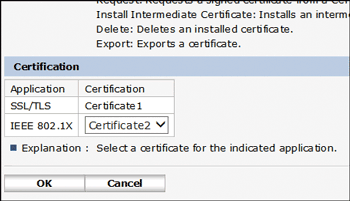
![]() Click [OK].
Click [OK].
![]() After completing the configuration, click [OK] and exit the Web browser.
After completing the configuration, click [OK] and exit the Web browser.
![]()
To print data in the machine using IPP-SSL, the user must install a certificate in the computer. Select "Trusted Root Certification Authorities" for the certificate store location when accessing the machine by IPP.
To change "Common Name" of the device certificate when using the Windows standard IPP port, delete any previously configured PC printer beforehand and install the printer driver again. Also, to change the user authentication settings (login user name and password), delete any previously configured PC printer beforehand, change the user authentication settings, and then install the printer driver again.
Encrypting Transmission Using SSL/TLS
SSL (Secure Sockets Layer) /TLS (Transport Layer Security) is a method to encrypt network communications. SSL/TLS prevents data from being intercepted, cracked, or tampered.
Flow of SSL/TLS encrypted communications
The user's computer requests the SSL/TLS device certificate and public key when accessing the machine.
The device certificate and public key are sent from the machine to the user's computer.

The shared key created on the computer is encrypted using the public key, sent to the machine, and then decrypted using the private key in the machine.

The shared key is used for data encryption and decryption, thus achieving secure transmission.

To enable encrypted communication, install a device certificate in the machine in advance.
To encrypt communication using SSL/TLS, enable SSL/TLS as follows:
Enabling SSL/TLS
![]() Log in to the machine as the administrator from Web Image Monitor.
Log in to the machine as the administrator from Web Image Monitor.
![]() Click [Configuration] from the [Device Management] menu.
Click [Configuration] from the [Device Management] menu.

![]() Click [SSL/TLS] on "Security".
Click [SSL/TLS] on "Security".
![]() Select the protocol to enable encrypted communication on "SSL/TLS" to specify the details about the communication method.
Select the protocol to enable encrypted communication on "SSL/TLS" to specify the details about the communication method.
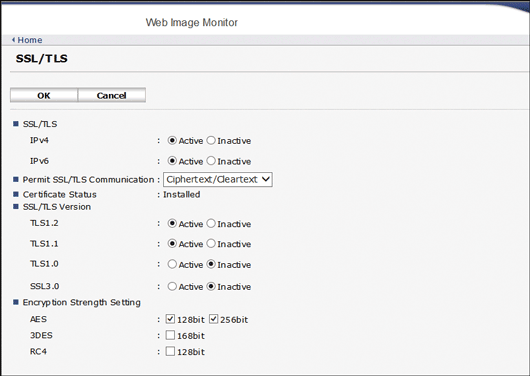
Permit SSL/TLS Communication: Select one of the encryption communication modes below:
Ciphertext Priority: Performs encrypted communication when a device certificate has been created. If encryption is not possible, the machine communicates data in clear text.
Ciphertext/Cleartext: Performs encrypted communication when connecting to the machine using an "https" address from a Web browser. Communicates in clear text when connecting to the machine using an "http" address.
Ciphertext Only: Allows encrypted communication only. If encryption is not possible, the machine does not communicate. If encryption is not possible for some reason, the machine cannot communicate. If this is the case, select [System Settings]
 [Interface Settings]
[Interface Settings] [Network]
[Network] [Permit SSL/TLS Communication] on the control panel, change the communication mode to [Ciphertext/Cleartext] temporarily, and then check the settings.
[Permit SSL/TLS Communication] on the control panel, change the communication mode to [Ciphertext/Cleartext] temporarily, and then check the settings.
SSL/TLS Version: Specify TLS1.2, TLS1.1, TLS1.0, and SSL3.0 to enable or disable. At least one of these protocols must be enabled.
Encryption Strength Setting: Specify the encryption algorithm to apply to AES, 3DES, and RC4. You must select at least one check box.
The following types of communication and data are always encrypted by SSL3.0: communication via @Remote and logs transferred to Remote Communication Gate S.
![]() Click [OK].
Click [OK].
![]() After completing the configuration, click [OK] and exit the Web browser.
After completing the configuration, click [OK] and exit the Web browser.
To encrypt communications with the SMTP server, use the following procedure to change "SSL" to [On].
Enabling SSL for SMTP connection
![]() Log in to the machine as the administrator from the control panel.
Log in to the machine as the administrator from the control panel.
![]() On the Home screen, press [Settings].
On the Home screen, press [Settings].
![]() Press [Machine Features Settings] on the Settings screen.
Press [Machine Features Settings] on the Settings screen.
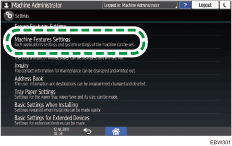
![]() Press [System Settings]
Press [System Settings] [File Transfer]
[File Transfer] [SMTP Server] to display the setting screen.
[SMTP Server] to display the setting screen.
![]() Press [
Press [ ], and then press [On] of "Use Secure Connection (SSL)".
], and then press [On] of "Use Secure Connection (SSL)".
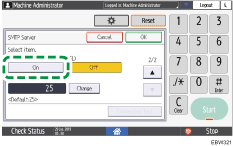
After completing the configuration, the port number changes to 465 (SMTP over SSL). When using SMTP over TLS (STARTTLS) for encryption, change the port number to 587.
When you specify the port number to a number other than 465 and 587, the communication is encrypted according to the setting in the SMTP server.
![]() Press [OK].
Press [OK].
![]() After completing the configuration, press Home (
After completing the configuration, press Home ( ).
).
![]()
When SSL is enabled in the SMTP server, Internet fax is always sent via the SMTP server.
Encrypting Data Communicated with Machine Management Software Via SNMPv3
When monitoring devices using Device Manager NX via a network, you can encrypt the transmitted data by using the SNMPv3 protocol.

![]() Log in to the machine as the administrator from the control panel.
Log in to the machine as the administrator from the control panel.
![]() On the Home screen, press [Settings].
On the Home screen, press [Settings].
![]() Press [Machine Features Settings] on the Settings screen.
Press [Machine Features Settings] on the Settings screen.

![]() Press [System Settings]
Press [System Settings] [Interface Settings]
[Interface Settings] [Network]
[Network] [Permit SNMPv3 Communication] to display the setting screen.
[Permit SNMPv3 Communication] to display the setting screen.
![]() Press [Encryption Only].
Press [Encryption Only].
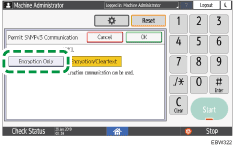
![]() Press [OK].
Press [OK].
![]() After completing the configuration, press Home (
After completing the configuration, press Home ( ).
).
![]()
To change the settings specified in the machine from Device Manager NX, specify an encryption password to the administrator in [Program/Change Administrator], and then register the encryption password in the SNMP account of Device Manager NX.
Encrypting the Login Password of Print Jobs
You can encrypt the login password for the printer driver and the password for IPP printing to increase security against password cracking.

To perform printing from a LAN inside the office, specify the driver encryption key.
To perform IPP printing from an external network, encrypt the password of IPP printing.
Specifying a Driver Encryption Key to Encrypt Passwords
Specify the driver encryption key specified in the machine also to the printer driver to encrypt and decrypt passwords.
![]() Log in to the machine as the administrator from the control panel.
Log in to the machine as the administrator from the control panel.
![]() On the Home screen, press [Settings].
On the Home screen, press [Settings].
![]() Press [Machine Features Settings] on the Settings screen.
Press [Machine Features Settings] on the Settings screen.

![]() Press [System Settings]
Press [System Settings] [Administrator Tools]
[Administrator Tools] [Extended Security]
[Extended Security] [Driver Encryption Key] to display the setting screen.
[Driver Encryption Key] to display the setting screen.
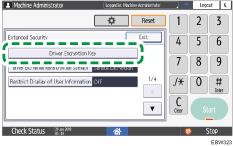
![]() Enter a character string to use as the driver encryption key, and then press [OK].
Enter a character string to use as the driver encryption key, and then press [OK].
![]() After completing the configuration, press Home (
After completing the configuration, press Home ( ).
).
![]() The administrator must give users the driver encryption key specified on the machine so they can register it on their computers.
The administrator must give users the driver encryption key specified on the machine so they can register it on their computers.
Make sure to enter the same driver encryption key as that specified on the machine.
When using an PCL 6 printer driver, you can enter the driver encryption key on [Printer Properties]
 the [Advanced Options] tab.
the [Advanced Options] tab.
Encrypting the password of IPP printing
When printing using the IPP protocol, specify the authentication method to [DIGEST] to encrypt the IPP authentication password. Register the user name and password for IPP authentication separately from the user information in the address book.
![]() Log in to the machine as the administrator from Web Image Monitor.
Log in to the machine as the administrator from Web Image Monitor.
![]() Click [Configuration] from the [Device Management] menu.
Click [Configuration] from the [Device Management] menu.

![]() Click [IPP Authentication] in the "Security" category.
Click [IPP Authentication] in the "Security" category.
![]() Select "DIGEST" on "Authentication".
Select "DIGEST" on "Authentication".
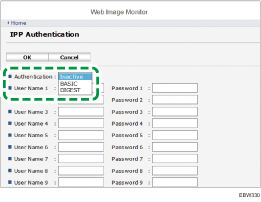
![]() Enter User Name and Password.
Enter User Name and Password.
![]() Click [OK].
Click [OK].
![]() After completing the configuration, exit the Web browser.
After completing the configuration, exit the Web browser.
Encrypting Communication Between KDC and the Machine
You can encrypt communications between the machine and the Key Distribution Center (KDC) server when using Kerberos authentication with Windows or LDAP authentication to secure communication.
The supported encryption algorithm differs depending on the type of KDC server.
![]() Log in to the machine as the administrator from Web Image Monitor.
Log in to the machine as the administrator from Web Image Monitor.
![]() Click [Configuration] from the [Device Management] menu.
Click [Configuration] from the [Device Management] menu.

![]() Click [Kerberos Authentication] of the "Device Settings" category.
Click [Kerberos Authentication] of the "Device Settings" category.
![]() Select the encryption algorithm to enable.
Select the encryption algorithm to enable.
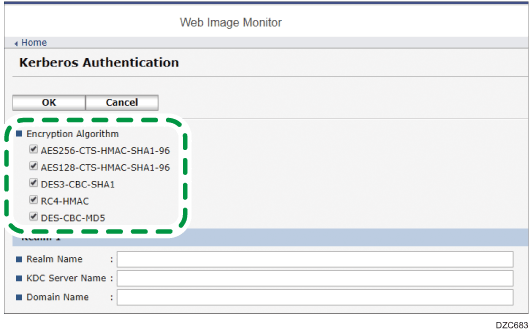
Only Heimdal supports DES3-CBC-SHA1.
To use DES-CBC-MD5 in Windows Server 2008 R2 or later, enable it in the operating system settings.
![]() Click [OK] and exit the Web browser.
Click [OK] and exit the Web browser.
